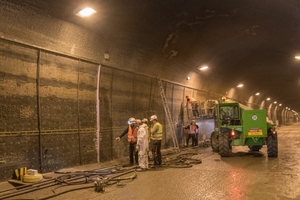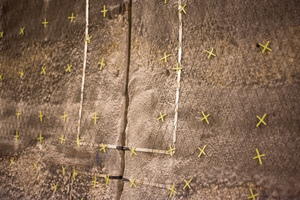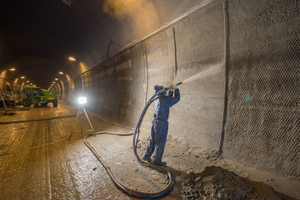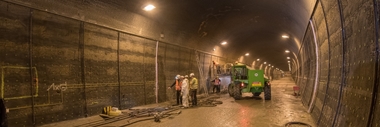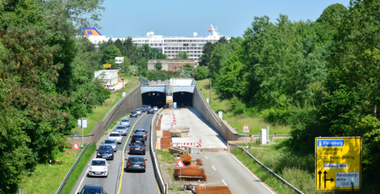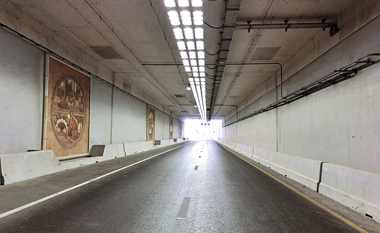First Tunnel Refurbishment with Cathodic Corrosion Protection in Germany
Classical renovation methods did not turn out to be practical for redeveloping the Rendsburg Canal Tunnel in Germany. But cathodic corrosion protection (CCP) emerged as a long-term solution. This internationally tried-and-tested technology could well feature big in Germany in future.
After the Hamburg Elbe Tunnel dating from 1912, the two-tube 640 m long Rendsburg Canal Tunnel, which opened in 1961, was the second underwater tunnel built in Germany for road traffic. Now it is the first tunnel in this country to be equipped with cathodic corrosion protection. Particularly in the winter months, the thawing salt carried in by up to 50 000 vehicles per day via the drag water resulted in high chloride exposure on the tunnel walls and carriageway. Conventional redevelopment measures undertaken on the ferro-concrete reinforcement and reworking the concrete failed to provide a lasting impact. As a consequence, the CCP method was applied for basic refurbishment. This method has been used successfully to renovate marine structures, bridges, parking facilities and tunnels throughout the world for over 30 years.
Cathodic Corrosion Protection – Functional Principle
Cathodic corrosion protection prevents the anodic sub-process (metal dissolution) affecting reinforcing steel, which ultimately leads to its destruction. For this purpose, a direct current is set up opposing the corrosion current. This is fed from electrically charged anode gates installed comprehensively in the concrete to the reinforcing steel also set under direct current and now cathodic. Positively charged ions (OH+, K+, Ca2+) flow to the reinforcement and all negatively charged ions (OH-, CI-, SO42-) flow from the reinforcement out of the concrete to the anode gate. Pitting of the reinforcing steel is reduced to almost zero.
Installing the CCP System
The tunnel wall concrete was first of all renovated using the PCC II-System Sika MonoTop-600; it comprises corrosion protection, a bonding bridge, coarse mortar and in part, a fine filler. The damaged steel parts had then to be connected with the steel reinforcement. This turned out to be a major task as there were subsequently 15 000 defects rather than the 2000 damaged spots initially estimated. First of all, a SPCC mortar layer SikaCem Gunit-212 SF was installed. Then the titanium mixed oxide anode gates were put in place. After assembling the spacers for the second layer of mortar, the positioning of the anode gates was checked and the CCP control system prepared. The installer then applied SikaCem Gunit-212 SF by the back-step method in the individual spraying sectors on the anode gates so that they were completely embedded. Following the SPCC mortar, the two-component fine filler Icoment-520 mortar was installed and subsequently rubbed clean. Finally, the tunnel walls were provided with an OS 4-coating with Sikagard Walcoat T, a two-component dispersion finish based on epoxide resin.
High-Grade Anode Base Coat Mortar with Fire Protection
SikaCem Gunit-212 SF is specially approved for installing anode gates for CCS and also possesses the high fire resistance class F 90 required for tunnels. Should fire break out, the concrete thus retains its strength for a 90-minute period. The high-grade dry spraying mortar is one of the few products on the market, which possesses these two properties and has successfully passed the rigorous testing procedure. A machine concept specially devised by Sika enabled the unusually long delivery range of the sprayed mortar over a distance of 400 m. As a result, demixing of the material over the entire distance was precluded. The dry spraying machine Aliva-246 was applied to process SikaCem Gunit-212 SF.
Open to Traffic in 2020
SikaTop ES-104 was used for reprofiling the tunnel floor and the installation of the CCS with SikaTop ES-108. Further Sika systems were applied for the carriageway substructure and waterproofing as well as for the tunnel accesses and exits. The redevelopment of the tunnel’s east tube below the North-East Canal has been completed in the meantime. After finishing the work in the west tube, the Rendsburg Canal Tunnel is scheduled to be open to traffic in February 2020.

